There are lots of other fish that will live happily with your goldfish. Just bear in mind, goldfish can grow fairly large, and if another fish is small enough to fit in the goldfish’s mouth, one day, it will go there!
Fancy goldfish are one of my favorite fish in the hobby. A large tank with 10 fancy goldfish bumbling around is just a pleasure to watch. However, I understand there are occasions you want to add some variety to your goldfish tank. Over the years I have tried a number of different combinations and I’ve listed 12 of my favorites below
- Another Goldfish
- Bristlenose Plecostomus
- Rosy Barbs
- White Cloud Mountain Minnows
- Dojo Loach
- Zebra or Leopard Danios
- Hillstream Loach
- Rubbernose Pleco
- Rice Fish
- Flagtail Hoplo Catish
- Variatus Platy
- Apple Snails
First, let’s look at what makes a suitable tank mate for your goldfish. To be suitable, the new fish species must match all of the criteria below.
- Only pick tank mates that can tolerate the same water conditions as your goldfish. Goldfish like their water temperature to be between 50-70°F. This does mean that they can comfortably live at room temperature without an aquarium heater. Some of the fish on this list would struggle at the lower temperatures. Goldfish also prefer harder water. Don’t’ choose a soft water loving fish that likes high temperatures, it will just fall apart in your goldfish tank.
- Pick Tank mates that share food requirements. Whichever fish you choose, make sure they eat similar, if not the same food as the goldfish. If the fish you add to your goldfish tank only wants to eat livefoods, but you only give your goldfish flakes or pellets, the other fish will eventually starve.
- Think about how fast goldfish swim. Fancy goldfish just bumble around the tank, struggling to stay up right most of the time. Common goldfish on the other hand are sleek and built for speed. Common goldfish can race around the tank and dominate the food preventing the other fish eating. Fancy goldfish are slow swimmers. If you pick fast swimming tank mates, the tank mates may dominate the food and your fancy goldfish might starve!
- Avoid aggressive tank mates. Goldfish are gentle, peaceful fish by nature and they can easily be bullied by stronger, more dominant fish. For this reason, goldfish should never be kept with African Cichlids, larger South American Cichlids and more aggressive barbs like Tiger Barbs.
- Avoid small fish. Goldfish are greedy and when they become larger, have a fairly large mouth. If you add very small or ‘nano’ fish, the goldfish will eventually eat them.
12 Fish That Can Live With Goldfish
Another Goldfish
Other goldfish are clearly the natural choice as tank mates for YOUR goldfish. There are many different varieties of fancy goldfish available these days, so you can have a pretty varied tank just sticking with goldfish. It is not a good idea to mix common goldfish (including comets) and fancy goldfish (fantails, ranchus, lionheads, etc). Common goldfish are very fast swimmers. If you mix them with fancy goldfish, the commons will dominate the food and your fancy goldfish will eventually starve.
If your existing goldfish are large, don’t add tiny, new goldfish to the tank. The larger fish may see the small ones as a good meal.

Bristlenose Plecostomus
Post on a forum ‘can you keep a Bristlenose with goldfish?’ and people will instantly respond saying you can’t! Well, I have done it and with good success. I had 4 fancy goldfish with a female Bristlenose. The combination worked fantastically. The two species left one another alone and the tank was always spotless of algae because the Bristlenose took care of it. You may hear people say that Bristlenose will suck the slime coat off your goldfish. I never saw evidence of that.
One word of caution. It can be tricky feeding the Bristlenose because the goldfish are so greedy. I found the solution was to feed the Bristlenose after the lights go out. I would drop in some good quality wafers or a block of Repashy and the Bristlenose would feast every night.
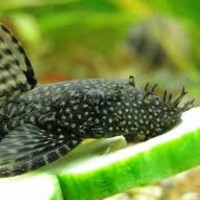
Rosy Barbs
You may well have heard that barbs can be aggressive towards fish with flowing fins. Generally, that is true. They are known ‘fin nippers. I have found that Rosy Barb aren’t too anywhere near as aggressive providing you take the 2 following tips into account. Firstly, keep a good-sized school of Rosy Barbs.
The more Rosy Barbs you have, the less aggressive individual fish tend to be. They are so busy spending time with their own species, that they don’t take any notice of other fish. A group of 10-15 or more is probably where you should aim. Secondly, Rosy Barbs are fast swimmers, so they are definitely better suited to a tank with common goldfish rather than fancy goldfish. The Rosy Barbs may eat all the food before the fancy goldfish get a chance to eat.

White Cloud Mountain Minnows
White Cloud Mountain Minnows are seriously underrated in our hobby. If you are not familiar with White Clouds, they are silvery grey or golden in color and they reach 1 to 1 and ½ inches long. White Clouds are tolerant of colder temperature water and they will happily live in an unheated aquarium.
Because they are quite small, White Clouds are better suited to a fancy goldfish tank. A large common goldfish could easily eat a minnow that strayed too close.
White cloud minnows are a schooling fish, so purchase 6 or more from your local store. If they are very small, consider growing them on for a few months before adding them to your goldfish tank.
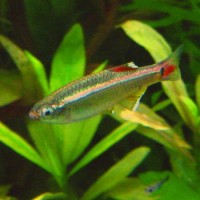
Zebra Or Leopard Danios
Zebra or Leopard danios make great companions to common goldfish. These danios are fast swimmers, constantly active, and surprisingly colorful once they mature. These are schooling fish so consider getting an absolute minimum of 6, but 10 or more is better. Both Zebra and Leopard Danios are cheap, so buying a larger school won’t break the bank.
These little fish are super hardy. They are often recommended as starter fish. They don’t mind cooler water, but the tank will need to be maintained around the low 70’s as a minimum. They aren’t fussy about what they eat and will happily thrive on the same diet as the goldfish.

Hillstream Loaches
If you want a fish that stops people in their tracks, go for one of the Hillstream Loaches. There are several to choose from including the Borneo Sucker Loach, the reticulated hillstream loach, and the Chinese Butterfly Loach.
Hillstream Loaches can be found constantly stuck to the glass or rocks. They primarily eat algae, but will also happily scavenge any leftover food lying around the aquarium. Like many of the other fish on my list, Hillstream Loaches are more than happy living in a tank that is kept at room temperature.
One thing to be aware of with many of the Hillstream Loaches is the fact they are nearly impossible to catch. You try netting one out of a tank that has rocks and wood in it. Trust me, you’ll lose your mind!

Rubbernose Pleco
Rubbernose Plecos, also sometimes called Bulldog Plecos, are a great alternative to Bristlenose Plecos. Much of their care requirements are the same, although the Rubbernose will like the water to be slightly warmer.
Aim for the low 70’s as a minimum. Rubbernose plecos grow to around 6 inches long and will appreciate at least one cave or hiding place per fish. I’ve used a terracotta flower pot on its side before.
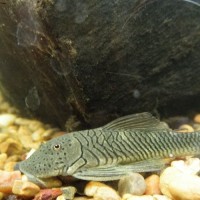
Rice Fish
I can not understand why more people don’t keep Rice Fish. These nippy little fish are very similar in their care requirements to White Clouds. They are happy in cooler water (they can even live outside in all but the coldest regions). The most common colors for these fish are orange, blue, and platinum.
Rice fish are unfortunately a little more expensive than White Clouds, but they are fairly easy to breed in the home aquarium. You could either buy a small group, breed them in a separate tank, then add a school to your goldfish, or pack your goldfish tank densely with plants and see if the Rice Fish will breed in the goldfish tank.
Once you have kept your first tank of Rice Fish I am certain you won’t ever want to be without them in the future.

Flagtail Hoplo Catfish
Flagtail Hoplo Catfish are docile, active fish which grow to around 6 inches long. They spend most of their day roaming around the bottom of the tank looking for any food they can consume. Because they are active during the day, there is no need to worry about the goldfish eating all their food. Hoplo’s search for food using their long whiskers.
Other species of Hoplo Catfish which may be suitable for your goldfish tank include the Spotted Hoplo and the Tail Bar Hoplo.
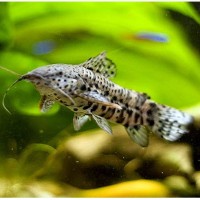
Variatus Platy
Not to be confused with regular platy’s, Variatus Platy will happily live in cooler water. Variatus Platy are a livebearing fish (meaning they don’t lay eggs, they give birth to free-swimming baby fish).
Variatus Platy come in a range of colors. Personally, the Sunset Variatus has always been a favorite, but they also come in blue and yellow forms. They are fairly undemanding fish and will happily consume whatever food the goldfish are eating.
One thing to bear in mind with this fish is, because they are livebearers, they will eventually breed in your tank. The problem is, the goldfish will eat some of those baby fish. If that isn’t something you can accept, maybe choose a different species.
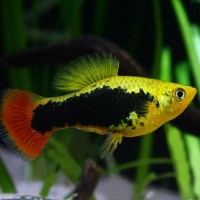
Apple Snails
Ok, so snails aren’t fish, but they are still worth mentioning in the same article though. Apple snails make great companions for goldfish as they will happily just wander around the tank eating algae off the glass or rocks, or consuming uneaten food. Apple Snails will also eat fish poop, breaking it down further and increasing the chances of it being sucked out of your tank into your filter.
If the goldfish try to eat the snail, he will just curl up in his shell until the goldfish moves on, then come out and carry on with his day.

What Fish Shouldn’t You Keep With Goldfish?
So clearly this list could go on forever, so I will try to choose some common mistakes people make.
- Corydoras. Corydoras themselves don’t pose a threat to the goldfish apart from the fact goldfish seem to like to eat them. This is a problem because corydoras have spiny fins. There are countless reports of veterinary surgeons and store owners being asked to cut the corydoras or from the goldfish throat or gill plates. You could probably go for a corydoras like fish known as Brochis multiradiatus. They reach around 4 inches in length, and although they also boast very spiny fins, goldfish are far less likely to try to eat such a large tankmate.
- African or South American Cichlids. Both African and South American Cichlids tend to be far too aggressive for goldfish. They also generally want the water to be much warmer than the goldfish do. South American Cichlids in particular often require much softer water than goldfish.
- Bettas. Bettas tend to be very aggressive towards other fish with long flowing fins. They will happily start a fight with a fancy goldfish and the goldfish will almost certainly come off worse. Stick with keeping Bettas in their own tanks.
- Common Plecos. Common plecos need huge aquariums and have huge appetites. It is very hard for the average aquarist to provide sufficient food for a common pleco which can lead to the pleco trying to eat the goldfish. Do yourself a favor and just avoid common pleco at all costs
In Conclusion
There are lots of fish you can put with your fancy goldfish. Just take your time and work out which ones are the best fit for you. Remember, goldfish are messy eaters and create a lot of waste. Every fish you add to that tank adds to the bioload the filter has to deal with. More fish may lead to more frequent water changes and filter cleaners.
A large aquarium with 3 or 4 fancy goldfish and a large school of Rosy Barbs or White Cloud Mountain Minnows is a spectacular sight and certainly a tank that will impress anyone who sees it.







